TROCHOPHORE LARVA:
In the life history of Nereis trochophore larva is seen. It is an unsegmented, small ciliated larva. It has a broad anterior end and a narrow posterior end. The digestive system is curved- It opens through mouth on lateral side. It leads into oesophagus stomach, intestine. Above the mouth a pre oral band of cilia will be present. Below the mouth a post oral band of cilia will be present.
With the help of the cilia the larva swims. At its apex a apical tuft of cilia will be present. Below it a cerebral ganglion & 2 eyes are present. This larva will develop into adult animals after some time.
Imagine a microscopic, translucent creature, barely visible to the naked eye, gracefully twirling through the vast ocean currents. This isn't a whimsical fairy-tale character, but a real-life marvel known as the trochophore larva. This tiny, free-swimming stage is a crucial part of the life cycle for many marine invertebrates, particularly annelids (segmented worms) and mollusks (like snails and clams). Far from being a mere "baby animal," the trochophore is a testament to the intricate dance of life in our oceans, playing vital roles in species dispersal, ecosystem health, and providing invaluable clues to the evolutionary history of diverse animal groups.
Key Insights into the Trochophore Larva
- Widespread Presence: Trochophore larvae are a common larval form found in marine annelids and mollusks, showcasing a shared evolutionary heritage.
- Ciliary Locomotion and Feeding: Characterized by distinctive bands of cilia, these larvae are master swimmers and efficient feeders, capturing microscopic plankton.
- Evolutionary Significance: The trochophore is considered a critical link in understanding the relationships among major animal groups, particularly within the Lophotrochozoa.
What Exactly is a Trochophore Larva?
At its core, a trochophore larva is a developmental stage that hatches from an egg, typically in the marine environment. It's often described as being pear-shaped or oval, remarkably translucent, and quite small – think the size of a grain of sand. What truly sets it apart, and gives it its name (from Greek words meaning "wheel-bearer"), is the presence of one or more bands of microscopic, hair-like structures called cilia. These cilia beat rhythmically, creating a mesmerizing "wheel-like" appearance and enabling the larva to move through the water and efficiently gather food.
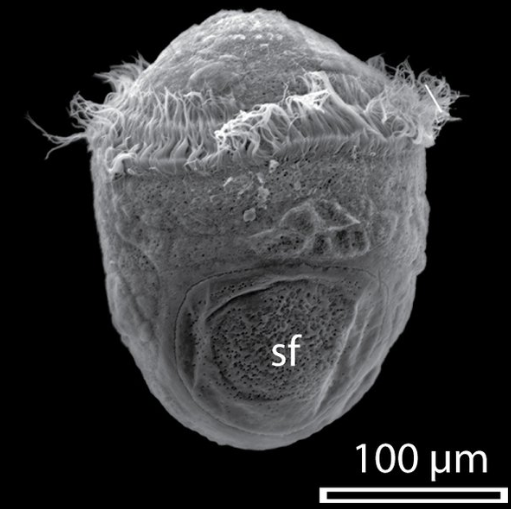
A microscopic view of a trochophore larva, highlighting its characteristic ciliary bands.
Anatomy of a Tiny Traveler
Despite its minute size, the trochophore larva boasts a surprisingly organized structure:
- Apical Plate: Located at the top (anterior) end, this region often features a tuft of sensory cilia. These cilia act like tiny antennae, allowing the larva to sense its surroundings, detect changes in light, temperature, or chemical cues, and navigate its watery world.
- Prototroch: This is the most prominent feature – a primary, often wheel-shaped, band of cilia encircling the larva's middle. The coordinated beating of these cilia is responsible for the larva's propulsion, allowing it to swim freely. It also creates water currents that sweep food particles towards its mouth.
- Metatroch (in some species): Some trochophores possess a second ciliary band located behind the prototroch, which can assist in both movement and feeding.
- Pygidium and Growth Zone: At the posterior (rear) end, this area contains additional ciliary bands and is crucial for the larva's continued development and eventual metamorphosis into an adult form.
- Simple Gut: Internally, a basic digestive system is present, typically consisting of a mouth, stomach, and anus, allowing the larva to process the plankton it consumes.
Diverse Feeding Strategies
Trochophore larvae exhibit different feeding behaviors depending on the species:
- Planktotrophic: Many trochophores are planktotrophic, meaning they actively feed on phytoplankton and other microscopic organisms suspended in the water column. The ciliary bands are instrumental in generating feeding currents to capture these food particles.
- Lecithotrophic: Other trochophores are lecithotrophic, relying on yolk reserves stored within the egg for nourishment. These larvae generally have a shorter planktonic phase as they don't need to forage for food.
The Trochophore's Role in the Marine Ecosystem
Beyond its intricate structure, the trochophore larva plays several critical roles in the marine environment, significantly impacting the survival and distribution of many species.
Dispersal: Nature's Little Drifters
One of the most vital functions of trochophore larvae is dispersal. Many adult marine invertebrates are sessile (fixed in one place) or slow-moving. The free-swimming, planktonic nature of the trochophore allows their offspring to be carried by ocean currents, sometimes over vast distances. This widespread distribution is crucial for:
- Colonizing New Habitats: Larvae can settle in new, favorable locations, expanding the species' range.
- Genetic Diversity: Dispersal helps to mix genes between different populations, increasing genetic diversity and resilience against environmental changes.
- Avoiding Local Extinction: If a local adult population faces threats, larvae from other areas can repopulate the region, preventing complete extinction.
Food Web Dynamics
As part of the plankton, trochophore larvae are also an essential component of the marine food web. They serve as a food source for a variety of larger marine organisms, contributing to the energy flow within the ecosystem. Their ability to consume phytoplankton also means they play a role in regulating primary productivity in the oceans.
Evolutionary Significance: A Window into Ancient Ancestries
The trochophore larva is not just biologically important today; it holds profound significance for understanding the evolutionary history of life on Earth. Its widespread occurrence across different phyla is a strong indicator of a shared ancestry among these groups.
The Lophotrochozoa Connection
The presence of a trochophore or trochophore-like larva is a defining characteristic of a vast superphylum known as the Lophotrochozoa. This group includes annelids, mollusks, brachiopods, nemerteans, and others. The shared developmental pattern of the trochophore larva suggests that these diverse animals evolved from a common ancestor that also possessed this larval stage.
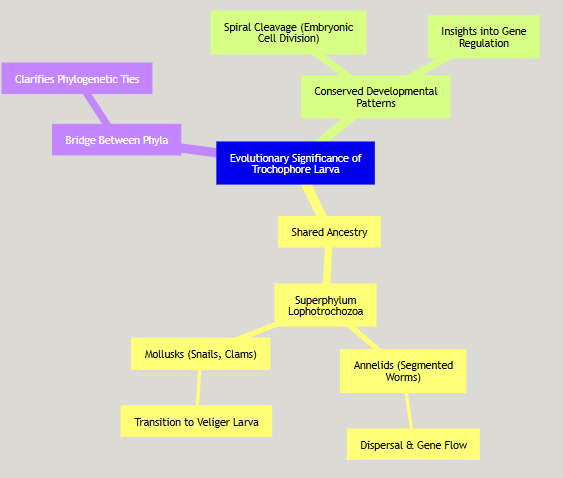
Mindmap illustrating the evolutionary importance of the trochophore larva, connecting it to shared ancestry and developmental patterns within Lophotrochozoa.
Developmental Clues: Spiral Cleavage
Further evidence for this shared ancestry comes from developmental processes, such as spiral cleavage. This specific pattern of cell division during early embryonic development is characteristic of many lophotrochozoans, including those that develop into trochophore larvae. Studying these conserved developmental traits helps scientists piece together the grand puzzle of animal evolution.
Life Cycle and Metamorphosis

The trochophore stage is usually temporary, a bridge between the egg and the adult form. Its duration can vary from a few hours to several days or even longer, depending on the species and environmental conditions.
The Molluscan Transition: Trochophore to Veliger
In many mollusks, the trochophore is an initial larval stage that undergoes further development to become a more advanced larval form known as a veliger larva. The veliger, often equipped with a shell and a ciliated 'velum' for swimming and feeding, is a specialized stage that precedes metamorphosis into the juvenile and then adult mollusk. This transition is vividly captured in the life cycle of creatures like oysters, where the trochophore rapidly develops into a D-shaped veliger.
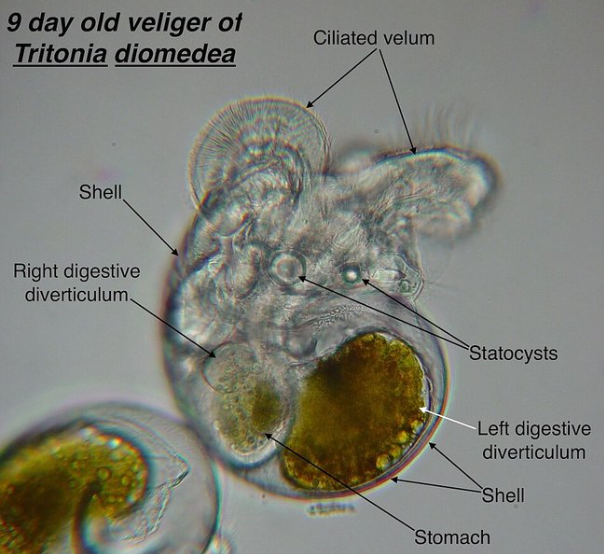
A veliger larva, the next developmental stage after the trochophore in many mollusks, featuring a developing shell.
The following video provides an excellent visual overview of the larval stages in mollusks, including the transition from trochophore to veliger, offering a dynamic perspective on these fascinating transformations:
This video explains the larval forms of Mollusca, including the trochophore and veliger stages, providing valuable context on their development.
Annelid Development
In many annelids, the trochophore larva may directly metamorphose into a juvenile worm, or it might pass through intermediate stages like the metatrochophore or nectochaete, gradually developing segments and adult features.
Beyond Biology: Practical Applications and Research
The study of trochophore larvae extends beyond fundamental biological curiosity, offering practical benefits and serving as a crucial model in scientific research.
Aquaculture and Fisheries
In aquaculture, understanding the health and development of larval stages like the trochophore is paramount for successful breeding and cultivation of marine species. For instance, in mollusk farming, ensuring optimal conditions for trochophore and veliger larvae directly impacts the productivity of hatcheries. Researchers are developing techniques for cryopreservation of these early life stages, which could revolutionize conservation efforts and aquaculture practices.
Developmental Biology and Genetics
Scientists utilize trochophore larvae as model organisms to investigate fundamental questions in developmental biology. Studies on gene expression during the trochophore stage provide insights into how complex body plans are formed and how evolution has shaped developmental pathways across different animal groups. The transparency and relatively simple structure of trochophores make them ideal candidates for observing cellular processes in real-time.
Comparative Analysis of Larval Forms and Traits
To further illustrate the diverse characteristics and significance of trochophore larvae, let's look at some comparative aspects using opinionated analysis of their biological roles and evolutionary traits.
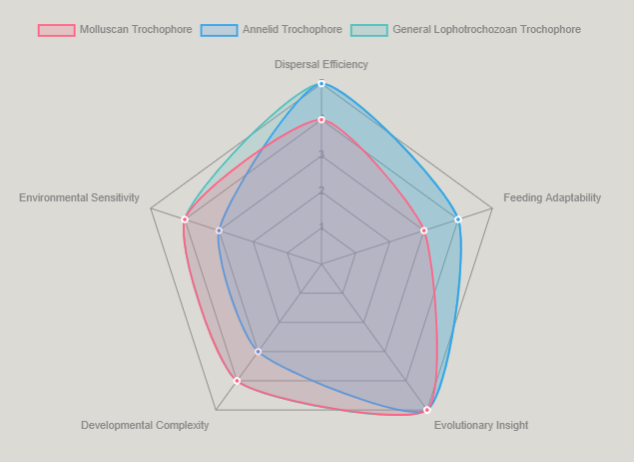
This radar chart compares different types of trochophore larvae based on key biological and evolutionary characteristics, illustrating their relative strengths and contributions. The values represent an opinionated analysis on a scale of 1 to 5, where 5 signifies high impact or adaptability.
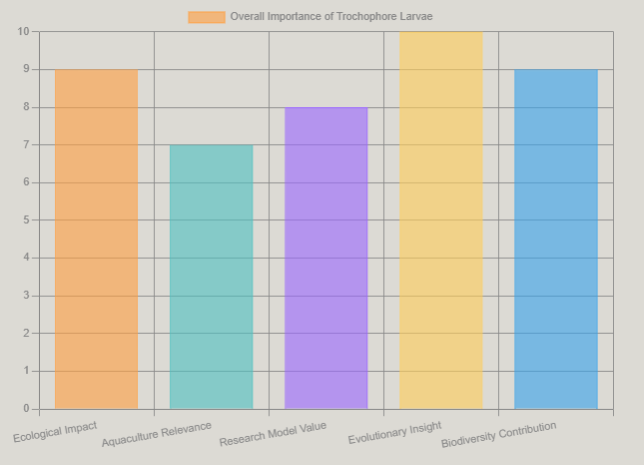
This bar chart illustrates the overall importance of trochophore larvae across various domains, from ecological impact to their value as research models. The values are an opinionated assessment on a scale of 0 to 10, with 10 indicating maximum importance.
Key Characteristics of Trochophore Larvae
The following table summarizes the essential features of trochophore larvae, drawing together their structural, functional, and evolutionary traits.
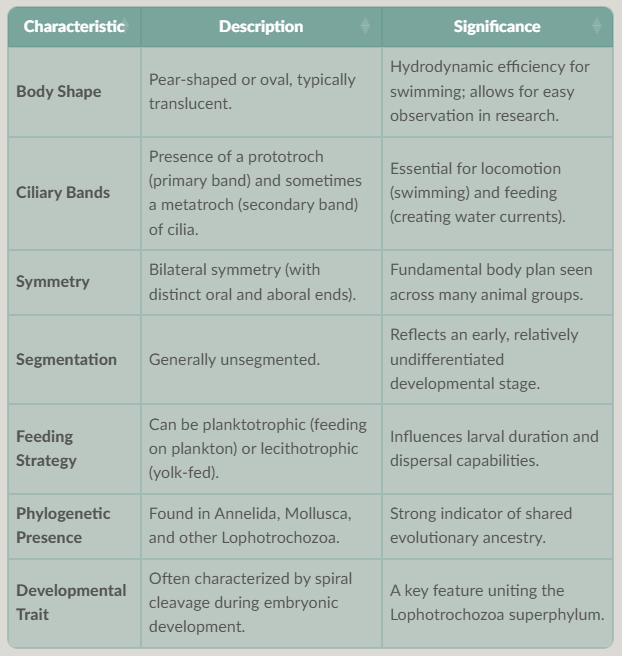
A Microscopic Marvel with Macro-Impact
The trochophore larva, despite its minuscule size and ephemeral existence, is a powerhouse of biological and evolutionary significance. From its elegant ciliary propulsion system enabling vast oceanic dispersal to its role as a living fossil, hinting at ancient lineages, this tiny creature embodies the delicate balance and interconnectedness of marine ecosystems. It serves as a vital link in the life cycles of countless marine invertebrates, ensuring the continuation and diversification of species. Understanding the trochophore not only deepens our appreciation for the complexity of early life stages but also provides critical insights for fields ranging from aquaculture to evolutionary biology, underscoring that even the smallest forms of life can have the most profound impacts.
References
